#how to create sewing patterns
Explore tagged Tumblr posts
Note
How do you make stuffed animals? I’ve bought a pattern for less complicated animals, but you made that blorbo and I don’t think there are any templates for that? What should be my next step in developing my animal making skills?
Hey! This answer is probably going to get pretty long, so it's going below a read more
You're right, I did not use a pre-existing pattern for the blorbo plushie. There's a couple different methods people use to create plushie patterns; if you find you don't like the method I use, that doesn't mean you can't make plushies! Keep trying until you find methods that work for you In my experience, the best way to develop skills in plushie pattern making is to sew a bunch of different plushies. While you use patterns, look at how the pieces look in 2D on the paper and how the end up in 3D in the finished plushie, and start to make a note of what it takes to make simple 3D shapes like a sphere (darts or different segments), a cube (six squares), a cylinder (a rectangle with two circles for the end pieces) If creating a new pattern entirely from scratch seems too much to start with, you can repurpose pieces of other patterns*! I've got a fluffy ostrich-y bird pattern that's just a pattern for a round dumpling for the body, a pattern for a...I think it was a snowball for the head, and then some simple rectangles to make the cylinders of the neck and legs. Another thing! A lot of plushie pattern making for simpler plushies made of knit fabric is just drawing. My manta ray patterns are just a drawing of a manta ray, plus a seam allowance added around the outside. Same with my eel pattern (mostly. it has one dart), my fish pattern, my other manta ray pattern...there's a lot of patterns you can make flat when you're starting out and use stuffing and the stretch of the fabric to make 3D. It's still what I use for simple flat pieces of patterns like wings, arms, ears, etc. That reminds me: seam allowances! I use 1/4" seam allowances, because that's what my sewing machine is set up for and it's the most common seam allowance I've seen used for plushies. You can use whatever seam allowance you want, but I have found it's a loooot easier if you have a tool you can use to add your seam allowance once you've drawn your pattern. I use two mechanical pencils taped together whose points are 1/4" apart. I put one pencil on the line I drew for the pattern, and use the other pencil to draw the line of the seam allowance. A few other tips, in no particular order but numbered so I can keep track of them 1. when matching up pieces of a pattern, make sure they match before the seam allowance is added. It'll make your life easier 2. fold paper to get symmetry in your pattern pieces 3. if you need to match a straight line to a curved line, or two curved lines together, you can use a pipe cleaner to measure the length of the curved line and then straighten the pipe cleaner to know how long to make your straight line (like matching the bottom of legs (rectangular pieces) to feet (circular pieces)) 4. If you are creating a pattern to use with a particular fabric, check how much of the fabric you have BEFORE you draw the pattern just like an inch too long to cut out of the fabric (I learned the hard way lol) 5. if you are worried your pattern won't turn out how you want it to, you can always start with monsters. There's no wrong way to make a monster plushie, you can just accidentally make a different monster than the one you intended to make. It's still a monster plushie, and that's not a bad thing to make! :D 6. if you have multiple pattern pieces coming together at the same point, like the top of a beach ball or the top of my octopus pattern, think about what angle you want that junction to form. For the octopus, I wanted the very top of it to be flat, so I made sure the pieces coming together totaled 360 degrees to be a flat circle. If I'd gone for less than 360 degrees, it would be pointed, if I'd gone for more, it would be kind of ruffled? Almost? Point is: divide the angle you want by the number of pieces you want to form that angle to get what the angle should be at the point each piece comes together *don't sell patterns made from pieces of other peoples' patterns though
#ask away!#weasel-the-scout#how to create sewing patterns#sort of. this is very freeform as I thought of it#if you (or anyone else) have more questions please feel free to ask!
30 notes
·
View notes
Text
Techno cosplay process, pt. 2!
Here we go again! It's been a while since I made that first post and admittedly I haven't made a lot of progress since then but I did a few first steps.
Over the last two days I've transferred the pattern of a cloak I got given to sturdier paper so I can use them more easily later. This is what that looked like.



I have also bought fabric for this cloak recently and I started making a checklist on cosplanner to keep track of the money and the time I'm spending on this project. I will buy more fabric as well as dye soon. Once those arrive I'll make an update again and show off the fabrics I'll be using for the base cloak.
Until then thank you for reading, I hope you have a good rest of your day! Hopefully this next update won't take as long as this one did lol
#technoblade cosplay process ^^#technoblade never dies#technoblade cosplay#techno cosplay#sewing#patterns#cosplay#how does one tag#indigo rambles#indigo creates
11 notes
·
View notes
Text
One side effect of my research for this novel being steeped heavily in textile history is my swelling disgust with modern fabrics.
Firstly they're so thin? Like most things you see in Old Navy or even department stores might as well be tissue paper?? Even some branded sports t-shirts I've bought in recent years (that are supposed to be 'official apparel' and allegedly decent quality) are definitely not going to hold up more than a year or two without getting little holes from wear.
This side of even two hundred years ago fabrics were made to be used for YEARS, and that's with wearing them way more often because you only owned like three sets of clothes. They were thick and well made and most importantly made to LAST. And they were gorgeous?? Some of the weaves were so fine and the drape so buttery we still don't entirely know how these people managed to make them BY HAND. Not to mention intricate patterning and details that turned even some simple garments into freaking ART.
I know this is not news, the fast fashion phenomenon is well documented. Reading so much about the amazing fabrics we used to create and how we cherished and valued them, though, is making it hard not to mourn what we lost to mass production and capitalism. Not just the quality of the clothing and fabrics themselves, but the generations of knowledge and techniques that are just gone. It makes me what to cry.
I need to get a sewing machine.
#textile history#fast fashion#textiles#weaving history#novel research#mass production#late stage capitalism#capitalist hell#fiber arts
9K notes
·
View notes
Text

I've noticed in the selfship community we don't talk a lot about ita bags and other DIY fan culture things much! To some extent it makes sense, as it might feel strange to some to have a lot of merch of someone you're viewing as a partner? But I've personally found it fun and wanted to share some video tutorials and inspiration for anyone else that might want a craft or project to dedicate to their f/o or comfort character!
links in this post go to tutorials/videos/templates!

Bags for displaying official or fanmade pins, keychains, and merch! There's a million ways to do this, but here's a couple to use as jumping off points.
using a standard premade ita bag!
using a nicer bag!
Making an ita bag out of a cheap PVC tote bag!


"But I can't afford merch/there's no official merch/etc!"
No problem, lets talk about how to diy that too!
You can use shrink plastic to make your own keychains!
You can also make pins in lots of different ways!
Using epoxy stickers
Using hot glue
Using a traditional can badge without a button maker
There are also Etsy sellers who will make custom badges from art as long as you have permission by the artist! If you have your own fanart, or can ask an artist you've commissioned, this would also be an accessible way while still looking more "official."
Finally, I believe these are usually used on Uchiwa fans (see later section), but I've used these paper letters alone as ita bag decorations! Name boards combine the letters or kanji of a character's name (or a different word relevant to the character) with their picture!
youtube

Do you have one standout badge that you'd like to highlight on your bag, or maybe you just want to make it into a keychain? Rosettes are great for that, and there's a million ways to make them. Here's a few!
1, 2, 3 , 4


Do you have paper goods such as photo cards or mini prints that need a safe but stylish way to be stored and displayed? Photo card holders are the way to go! There's a lot of different styles people like to use:
Resin Deco method
Lace and Ribbon method
Fake Cream (Decoden) method
Sticker method


Tutorials for photo cards do exist, and I will link them, but it's worth noting that it's a lot of work and the quality you get depends a ton on the quality of your printer. If you have access to an art printer, these will turn out great! If you're using a regular printer, however, you may be unsatisfied with the quality. Buying prints from small artists or having regular photos printed would be other alternatives.
Photo card tutorial focused on drawn art
Photo card tutorial focused on photos

Fans that are often printed with your favorite idol to use at concerts! While it originates there, people have started making them for their fictional favorites as decor too. You can create a full size fan (they sell blanks on amazon) or create a mini keychain version for an ita bag!


These can be quite complicated, but you can make your f/o as a plushie! Especially great for f/os who have no official plush merch.
This tutorial goes very fast, but it looks easy enough. This is only one example tutorial. There's also this pattern you can work with if you mostly understand sewing.
A more approachable plush like project would be these felt "plushies"!
You can also buy plushie bases like these , and then all that's left is the face, hair, clothes, etc.! You would probably approach it like in this video but the style would be up to you. I love how this creator embroiders faces!


I hope this gives you all some ideas to work with! 🩷
#self shipping#self ship#yumeship#yumeshipping#f/o stuff#f/os#fictional other#self ship art#self ship ideas#oshikatsu#yumedanshi#selfship#f/o community#mine
635 notes
·
View notes
Text
NASA Inspires Your Crafty Creations for World Embroidery Day
It’s amazing what you can do with a little needle and thread! For #WorldEmbroideryDay, we asked what NASA imagery inspired you. You responded with a variety of embroidered creations, highlighting our different areas of study.
Here’s what we found:
Webb’s Carina Nebula
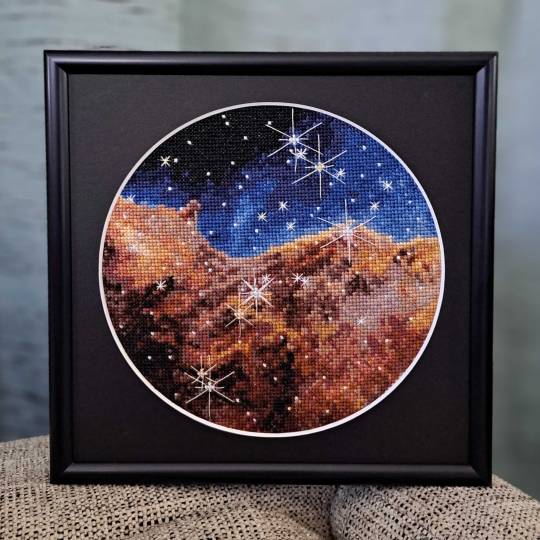
Wendy Edwards, a project coordinator with Earth Science Data Systems at NASA, created this embroidered piece inspired by Webb’s Carina Nebula image. Captured in infrared light, this image revealed for the first time previously invisible areas of star birth. Credit: Wendy Edwards, NASA. Pattern credit: Clare Bray, Climbing Goat Designs
Wendy Edwards, a project coordinator with Earth Science Data Systems at NASA, first learned cross stitch in middle school where she had to pick rotating electives and cross stitch/embroidery was one of the options. “When I look up to the stars and think about how incredibly, incomprehensibly big it is out there in the universe, I’m reminded that the universe isn’t ‘out there’ at all. We’re in it,” she said. Her latest piece focused on Webb’s image release of the Carina Nebula. The image showcased the telescope’s ability to peer through cosmic dust, shedding new light on how stars form.
Ocean Color Imagery: Exploring the North Caspian Sea
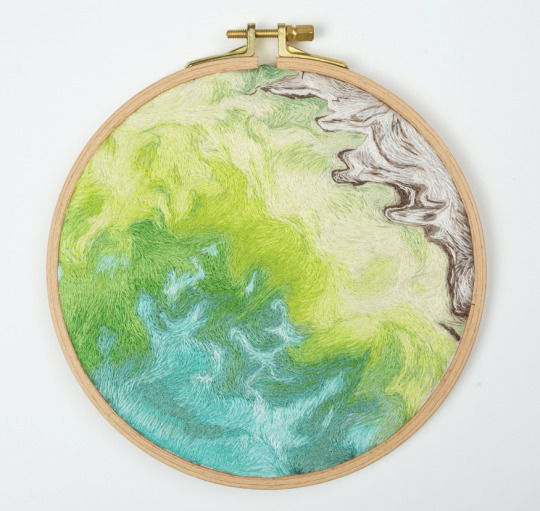
Danielle Currie of Satellite Stitches created a piece inspired by the Caspian Sea, taken by NASA’s ocean color satellites. Credit: Danielle Currie/Satellite Stitches
Danielle Currie is an environmental professional who resides in New Brunswick, Canada. She began embroidering at the beginning of the Covid-19 pandemic as a hobby to take her mind off the stress of the unknown. Danielle’s piece is titled “46.69, 50.43,” named after the coordinates of the area of the northern Caspian Sea captured by LandSat8 in 2019.
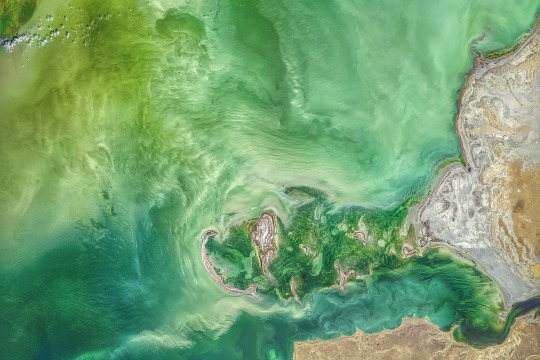
An image of the Caspian Sea captured by Landsat 8 in 2019. Credit: NASA
Two Hubble Images of the Pillars of Creation, 1995 and 2015
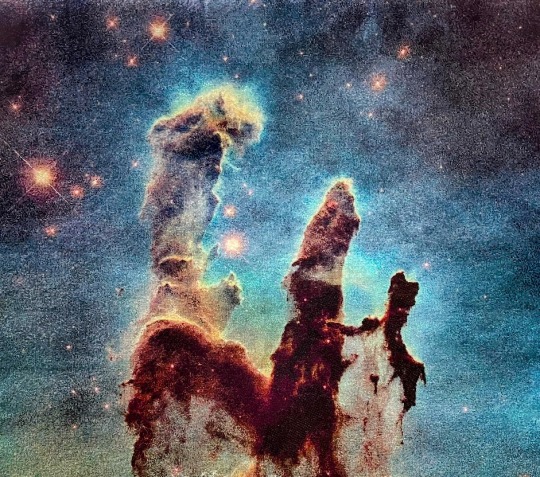
Melissa Cole of Star Stuff Stitching created an embroidery piece based on the Hubble image Pillars of Creation released in 1995. Credit: Melissa Cole, Star Stuff Stitching
Melissa Cole is an award-winning fiber artist from Philadelphia, PA, USA, inspired by the beauty and vastness of the universe. They began creating their own cross stitch patterns at 14, while living with their grandparents in rural Michigan, using colored pencils and graph paper. The Pillars of Creation (Eagle Nebula, M16), released by the Hubble Telescope in 1995 when Melissa was just 11 years old, captured the imagination of a young person in a rural, religious setting, with limited access to science education.
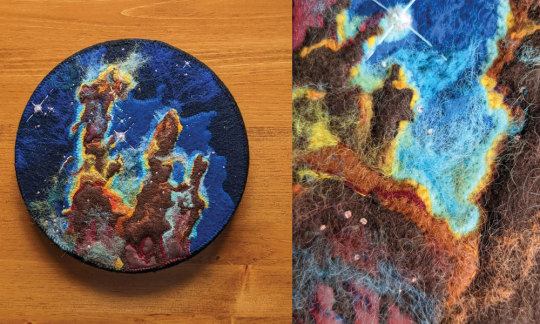
Lauren Wright Vartanian of the shop Neurons and Nebulas created this piece inspired by the Hubble Space Telescope’s 2015 25th anniversary re-capture of the Pillars of Creation. Credit: Lauren Wright Vartanian, Neurons and Nebulas
Lauren Wright Vartanian of Guelph, Ontario Canada considers herself a huge space nerd. She’s a multidisciplinary artist who took up hand sewing after the birth of her daughter. She’s currently working on the illustrations for a science themed alphabet book, made entirely out of textile art. It is being published by Firefly Books and comes out in the fall of 2024. Lauren said she was enamored by the original Pillars image released by Hubble in 1995. When Hubble released a higher resolution capture in 2015, she fell in love even further! This is her tribute to those well-known images.
James Webb Telescope Captures Pillars of Creation
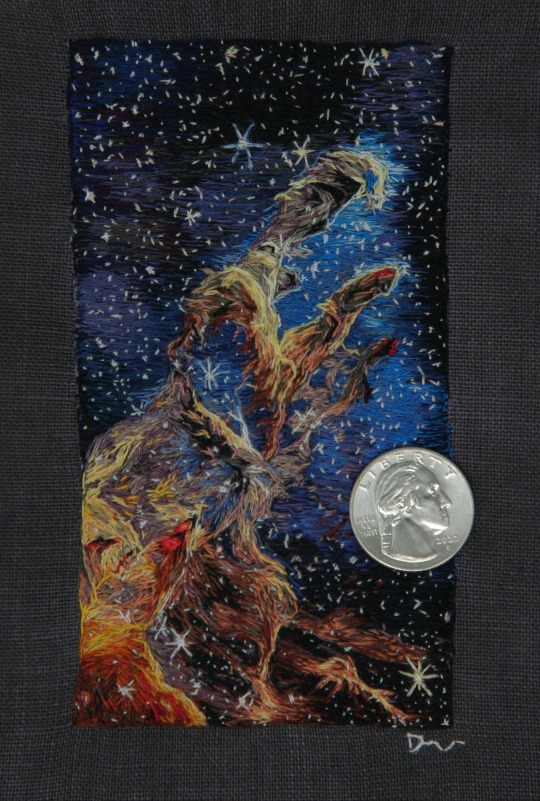
Darci Lenker of Darci Lenker Art, created a rectangular version of Webb’s Pillars of Creation. Credit: Darci Lenker of Darci Lenker Art
Darci Lenker of Norman, Oklahoma started embroidery in college more than 20 years ago, but mainly only used it as an embellishment for her other fiber works. In 2015, she started a daily embroidery project where she planned to do one one-inch circle of embroidery every day for a year. She did a collection of miniature thread painted galaxies and nebulas for Science Museum Oklahoma in 2019. Lenker said she had previously embroidered the Hubble Telescope’s image of Pillars of Creation and was excited to see the new Webb Telescope image of the same thing. Lenker could not wait to stitch the same piece with bolder, more vivid colors.
Milky Way
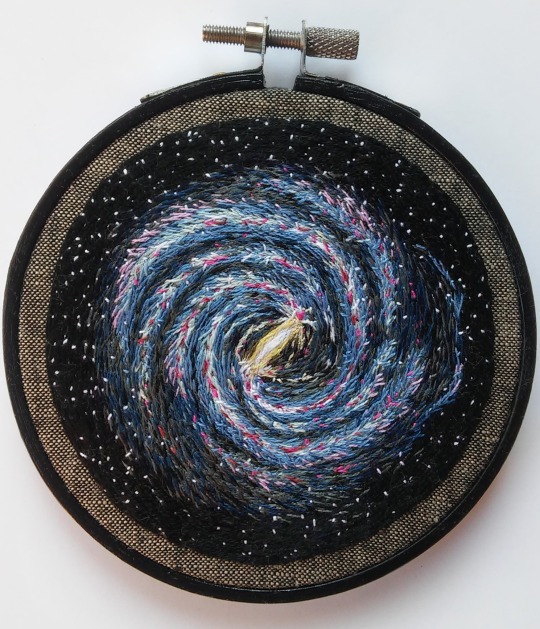
Darci Lenker of Darci Lenker Art was inspired by NASA’s imaging of the Milky Way Galaxy. Credit: Darci Lenker
In this piece, Lenker became inspired by the Milky Way Galaxy, which is organized into spiral arms of giant stars that illuminate interstellar gas and dust. The Sun is in a finger called the Orion Spur.
The Cosmic Microwave Background
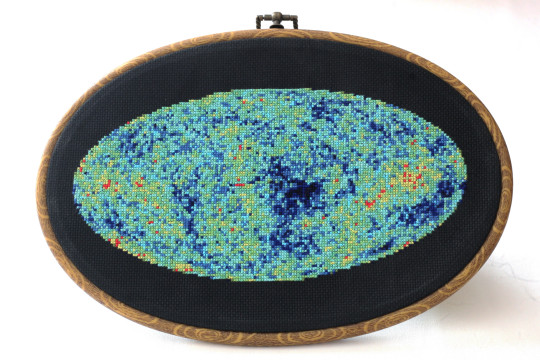
This image shows an embroidery design based on the cosmic microwave background, created by Jessica Campbell, who runs Astrostitches. Inside a tan wooden frame, a colorful oval is stitched onto a black background in shades of blue, green, yellow, and a little bit of red. Credit: Jessica Campbell/ Astrostitches
Jessica Campbell obtained her PhD in astrophysics from the University of Toronto studying interstellar dust and magnetic fields in the Milky Way Galaxy. Jessica promptly taught herself how to cross-stitch in March 2020 and has since enjoyed turning astronomical observations into realistic cross-stitches. Her piece was inspired by the cosmic microwave background, which displays the oldest light in the universe.

The full-sky image of the temperature fluctuations (shown as color differences) in the cosmic microwave background, made from nine years of WMAP observations. These are the seeds of galaxies, from a time when the universe was under 400,000 years old. Credit: NASA/WMAP Science Team
GISSTEMP: NASA’s Yearly Temperature Release
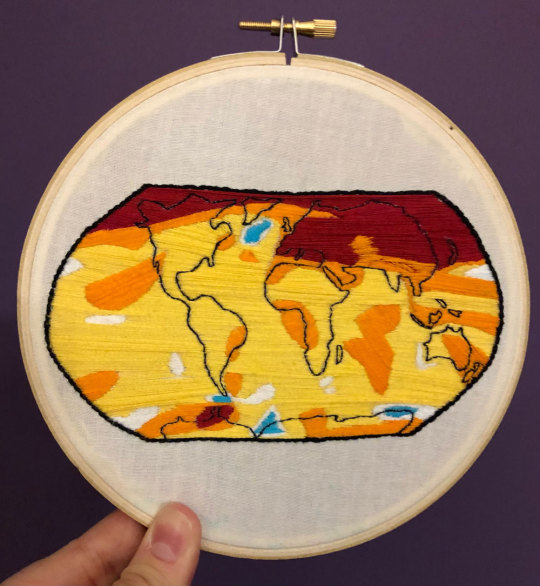
Katy Mersmann, a NASA social media specialist, created this embroidered piece based on NASA’s Goddard Institute for Space Studies (GISS) global annual temperature record. Earth’s average surface temperature in 2020 tied with 2016 as the warmest year on record. Credit: Katy Mersmann, NASA
Katy Mersmann is a social media specialist at NASA’s Goddard Space Flight Center in Greenbelt, Md. She started embroidering when she was in graduate school. Many of her pieces are inspired by her work as a communicator. With climate data in particular, she was inspired by the researchers who are doing the work to understand how the planet is changing. The GISTEMP piece above is based on a data visualization of 2020 global temperature anomalies, still currently tied for the warmest year on record.
In addition to embroidery, NASA continues to inspire art in all forms. Check out other creative takes with Landsat Crafts and the James Webb Space telescope public art gallery.
Make sure to follow us on Tumblr for your regular dose of space!
#NASA#creativity#fiber art#embroidery#art#art challenge#needlework#crafts#handmade#textile art#cross stitch#stitching#inspiration#inspo#Earth#Earth science#Hubble#James Webb Space Telescope#climate change#water#nebula#stars
6K notes
·
View notes
Text
Questions to ask yourself when creating a magic system
I have more questions for you!!! :D
As there are no real-word examples for this one, I’m going to be talking a lot about my own magic systems, and those of the medias I enjoy! There will be a list of all the things I referenced at the bottom!
What does magic DO
Exactly the title. What does magic do? (Can it make potions? Cast spells? Animate things? Transfigure things? Create things? Kill things? Cast hexes or charms? Multiple of these?)
What does magic have an affect on? What does it not?
How strong is magic? What are its limits? How do these differ from person to person, or place to place?
Does magic do different things for different people?
How does a magic caster’s intention for a ‘spell’ affect it? Is magic entirely reliant on a mental image of what is wanted, or does it need to be casted a certain way to work, like a recipe?
How is magic casted? (Note- I recommend being creative here! It doesn’t have to just be waving a wand. It can be through making pottery, it can be through sewing certain patterns, or dancing a certain dance, etc etc etc)
How can spells be used for something that is not their intended/common purpose? How are new uses of magic discovered? Which uses are most common, and why?
How does societal standards affect the use of magic? Will less people know about more harmful or taboo spells? Will it be less common for, say, a woman to use/be trained in magic?
Source of Magic
Where does magic come from? (Do the gods give access to their most devout followers? Is it handed down in one’s blood? Does it come from the earth?)
Is magic learnt, or are people born with it? (E.g does magic work through potions that can be made by anyone with the right ingredients, or is it only possible if one has magic already in their blood?)
Can someone who logically shouldn’t know magic learn/possess it by alternate means? (E.g. Luz from The Owl House learning magic via ‘glyphs’ despite not being a witch) how would people treat this? (Is it seen as ‘lesser’ or somehow not ‘real’ magic?)
Can magic be harnessed through a wand/staff/etc? Can it only function through this conduit, or can it be done without? How does magic function if it does not have the aforementioned conduit? (Is it harder to manage? Is it more dangerous? Is it simply lesser?)
Another dot-point because the last one was far too long; how is the use of ‘magical aides’ (wands, etc) treated? (Is it seen as something only a child would use? Is it very common? Is not using one seen as dangerous and bad?) How does the function of magical aides affect this? (Note- a very good example of this is the string in A Marvellous Light, which functions via ensuring a magicians cradles [hand movements one does to cast a spell] are more precise. It is only used by those with little magic, so it is looked down upon.)
How would one learn magic? (Is magic taught in schools? Are there books on it?)
Can magic be done/enhanced if multiple people cast it together? How would this be done?
Is magic a separate entity from it’s user? Is it an entity at all? Can it react without instruction/ disobey it’s user? Is it a possession of it’s user? Is this different/ perceived differently for different people?
Can magic be mistreated/ abused? (Note- here I do not mean an ‘abuse of power’ I mean abuse in the way one could abuse a pet) what are the consequences of this? (Might magic stop working, or turn on it’s user?)
Affect on Culture/the greater world
Who has magic? Who does not? Who knows about magic? Who does not? Is it a secret? How is this secret kept? Who enforces that it must be a secret? What is the punishment for letting the secret be known?
Can people have more or less magic? Can people have more or less knowledge on it, or skill with it? Does this cause any power imbalances or issues for either side?
How do the uses of magic impact the way things are done? (E.g. if there is a spell used to dry things, people may not use drying racks.) would the skills of those with more magic be useful in a work setting? (E.g. if some people know the aforementioned drying spell and some do not, might those who do know it work as something close to a washerwoman because of their skill?)
Is magic regulated at all? Who regulates it, what are the regulations, how strict are they, and what are the punishments for breaking them?
Is magic seen as normal? (Keep in mind: if magic is possessed by a majority of people, it very well may be. Because of this, characters may be less likely to be impressed by magic. Think about how this will affect the language surrounding magic, and how people treat it.)
How will different people view or interact with magic? (E.g. a rebellious teen, a businessman and an elderly woman are not going to have the exact same view or uses of magic. Try to explore this!)
How will those with a great deal of magic view those without/ without a great amount, and vice versa? How does this affect the world and it’s prejudices?
Consequences
How can magic hurt a person if misused/overused/ used at all? (Is the damage physical, mental, physiological, all three?) (E.g. my own magic system causes people to actively unmake themselves as they use their magic, leading to sickness, insanity, derealisation, hallucinations, etc etc etc)
Is this damage known? How does the knowledge of it affect the treatment of magic? (Are people terrified of it? Do they not care, and see it as a worthy risk? What might lead someone to push through the damage?)
How does this damage manifest, and how noticeable is it? (E.g. Are there physical scars or other warning signs, or is it entirely unnoticeable until it is too late, like magical rabies?)
Can damage from magic be reversed or healed? How? Can potential damage be avoided? How?
Can one’s magic turn on oneself? How would this happen, and what are the consequences of this?
Can magic be hurt/diminished? How does this affect its users? (E.g. silver and werewolves)
When an attempt at magic fails, how does it fail? Is it like baking, where at worst it’ll ‘taste good, but be a little dry’ or is it like mixing volatile chemicals, where at worst you die?
Appearance
How does magic look? (I highly recommend finding a metaphor or motif for magic, as this really helps flesh out its appearance and makes it easier to describe!!)
Can its appearance look different for different people? Can it change over time?
Does magic manifest itself via means other than visual? (One of my characters has very strong nature magic, and thus he grows flowers when he is happy, and always smells floral)
Does magic have a physical effect on it’s users? (E.g. the dark magic in The Dragon Prince)
Is one able to tell when magic has been cast upon something?
Every piece of media I referenced in this, in order of appearance
The Owl House, a TV show on Disney written by Dana Terrace
A Marvellous Light, a novel written by Freya Marske (this series is a wonderful example of how to make a magic system. It is very well thought out, and the varied experiences and views of magic for each magician character is so, so good. 10/10. If you want a good example of magic please read this!!! (Granted I might be a little biased because I just love this book series))
The dragon prince, a TV show on Netflix
215 notes
·
View notes
Note
Could I request TWST with a Yuu who's a fashion designer?
𝐓𝐖𝐒𝐓 𝐖𝐈𝐓𝐇 𝐀 𝐅𝐀𝐒𝐇𝐈𝐎𝐍 𝐃𝐄𝐒𝐈𝐆𝐍𝐄𝐑!𝐘𝐔𝐔👜


Fashion design is the art of applying design, aesthetics, clothing construction and natural beauty to clothing and its accessories. It is influenced by culture and different trends and has varied over time and place. "A fashion designer creates clothing, including dresses, suits, pants, and skirts, and accessories like shoes and handbags, for consumers. They can specialize in clothing, accessory, or jewelry design, or may work in more than one of these areas."
When waking up from the coffin and looking around, the first thing that came to mind was "ew" about the robes of the school. And not to mention Crowley could feel their judgmental eyes on his uniform.
When receiving the uniform of NRC, their minds would immediately think this won't be through so everyday they customize with different and unique patterns on their uniforms so everyday they stand out a lot not to mention how Fabolous their design is.
Many of the first years uniforms were also Tailor by them because they couldn't stand seeing their closest companion to wear such Dule outfits.
Not to mention fashion designer!yuu would fix their friends uniform when it's messy they even carry a sewing kit with them so they could fix any damage towards the uniforms.
Surprisingly is bad at school because they mostly focus on their career than at the subject in front of them, leading towards many lectures from crewel and trein. They may be a perfectionist every time they finish a design and think it would be good enough they would immediately throw it away and start over creating a never endless cycle.
Rarely sleep, like I said their work will come first meaning they tend to ignore self care so during at night and during the daytime after school would immediately straight to work.
Crowley was a victim of their judgemental eyes, literally every time when their eyes look at him. He could feel them inspecting their outfit choice and roasting they don't need to speak he could feel it instantly like a sharp knife.
After managing to get themselves a phone, they made an account and started to take pictures of their design and posted online, it got popular quickly and many celebrities would want to buy their luxurious outfits.
They absolutely despise mass production. Every piece is unique. Their motto: “Fast fashion is a crime; individuality is divine.” they believe every piece will take time and have to be unique on their own.
You know does memes that "find Gaga" that's them, they stand out the most due to how their fashion point and how their out fits are bold and unique they don't want to be the same as everyone forcing themselves to suppress their true self, they wanna to stand and bold.
A very bold person, doesn't sugar coat their words even tho it will hurt the person. Sometimes even roasting vil, they possessed mutual respect towards each other and vil sees them as a rivals towards each other.
#not canon#twisted wonderland#twst scenario#disney twst#twst headcanons#twst wonderland#twisted wonderland yuu au#twst mc#twst yuu au#twst x reader#twst#twisted wonderland x reader#fashion designer!yuu
239 notes
·
View notes
Text


Aglaea likes beautiful things. Her coreflame is romance and she has an eye for details. Despite her blindness, her fingers have long since memorized all the techniques to sew and her way around the threads, she's an expert at weaving meticulous patterns and the smallest additions that make the most beautiful pieces of clothing imaginable. When she creates, she creates with love, it's her respite, she spends endless hours refining every last detail to it's full potential. And you, are her muse. You inspire her to work even harder, so she could see you in all her dresses. When you're called in to try yet another garment she's finished up, you're already anticipating that indescribable feeling you'll get as soon as the fabric meets your skin. As if she weaved love and untold confessions into every single knot and thread. It makes you feel beautiful, she hopes you'll feel as beautiful as she sees you to be. When you look in the mirror, the giant dress dragging behind you, enough to capture the attention of even the Gods, you can feel how much her so-called frozen heart cares. How much warmth is in her unfocused gaze behind you in the mirror.


162 notes
·
View notes
Text
Pattern links! I have not added any since the last time I shared this, but as always, if you are seeing this and it's been a while since I added this update, check back to the original post because I will update it with links whenever I share new patterns
Links to my free sewing patterns! - big manta ray - smaller manta ray - monster friend (those monsters with horns I’ve been making lately, but without horns) - pie slice - Fred, the Fish of Minimal Effort - tiny cat (aka Jiji) - mini mothman - whale shark/donut whale shark - juggling frog/toad (aka my smallest, simplest frog pattern of the three I’ve made) - large frog - tiny hedgehog - minecraft bee - minecraft zombie - blorbo - Strawberry Hearts quilt pattern - starfish - little octopus - canvas tote - basic bat and ghost - mini mushroom friends Tutorials: - flannel baby blanket tutorial - onigiri bag tutorial - tomato pattern design walkthrough (how I design the pattern, not a link to the pattern itself)
#maybe that's what I'll do with my weekend#get another pattern shared#I think I have the whale one traced and scanned already it's just waiting on directions#I could probably make a whale this weekend and use it for wip pictures#because if I remember correctly it's a little weird to assemble#one of those patterns that I made and then was like. how did I do that. that's a more complicated technique than I knew that I knew#not that complicated to sew just a little more complex to draft than I usually go for#because in my experience creating patterns for plushies: you can either make the pattern drafting complicated in a way#that makes the sewing easier or you can make the pattern drafting easy in a way that makes sewing more complicated#and I usually opt for the latter. except in things like the octopi
12K notes
·
View notes
Note
what kind/style of endbands do you usually do? they look so good 👀
hi!! sorry for taking a while to answer, I wanted to make sure I could give you my best answer.
I usually do what's called a "double core" endband. I use double core endbands over the "bead on front" method because bead on front style is not great for uneven distributions of color, irregular patterns, or using more than three colors. Functionally it works by having your extra threads wrapped up inside the thread that is showing, forming the smaller secondary core. Ultimately you are doing figure 8s around the main core & then your secondary core of thread. This keeps things pretty neat & tidy. The tutorial I first used was this one by DAS Bookbinding, though I don't think his endband tutorials are his best ones. Another binder I've spoken with endbands about a lot is maleeka, who recently did an endband tutorial herself.
maybe I should do one... but it takes a lot for me to get enough motivation to make videos. I'll take this opportunity to write up some tips I've shared when people ask instead:
1. Endband core material is the MOST IMPORTANT component. You need a core that is stiff but flexible - it should NOT be floppy because it wiggles everywhere under the tension of the thread, but still needs to flex with the opening & closing of the book. You want something that doesn't compress, to reduce tension shifts in thread creating a lumpy endband. Have a smooth core is less critical but helps to avoid snagging threads & allows you some leeway on sliding threads around for adjustments. My personal choice is smooth leather jewelers cord (link is just an example, I get mine from a local craft store).
2. Thread size. All your threads need to be the same size; it will be visible if you are using two different sizes, and mess with your front core. Additionally, I know lots of people will use larger twists of multiple strands of embroidery thread, which can work, but is more likely to compress & alter its size in unexpected ways. A single strand is preferable. If you want something thicker you can find some thread weights that are heavier twists intended to be used in a single strand, not pulled apart. I prefer smaller sizes because it works better for the gradient designs I like.
3. Silk thread is your friend (if you can spend the money on it). It reduces fuzz (no fuzz like you get with cotton/DMC embroidery thread), it's usually easier to manage, has a more compact twist, and a higher shine. I use Japanese silk hand sewing thread in size #9 (9号). There's multiple brands (Tire, Daruma, KNK/kanagawa, etc). Here's a wholesale listing (minimum 20,000¥ for international). A non-Japanese brand is Guterman silk (German brand). Both the Japanese & German threads come in a heavier weight (Japanese is #16, Guterman is buttonhole).
4. Thread tension is the most important part of the actual technique. You need to ensure the threads currently wrapped in the secondary core keep tension when you are working the thread around them.
5. Working on a curve. This is only really relevant if you're doing an endband on a rounded book, but the circumference of the curve means there's more real estate on the outside vs inside of the curve. Sometimes this can cause bunching on the secondary core. My own solution to this is that sometimes I wrap the primary core but drop a wrap here or there around the secondary core (only between two wraps of the same color I'm dropping). I uh... don't know of anyone currently recommending this besides myself so I can't point to any pro endorsement for this method, it's just what works for me. Forgive my terrible writing:
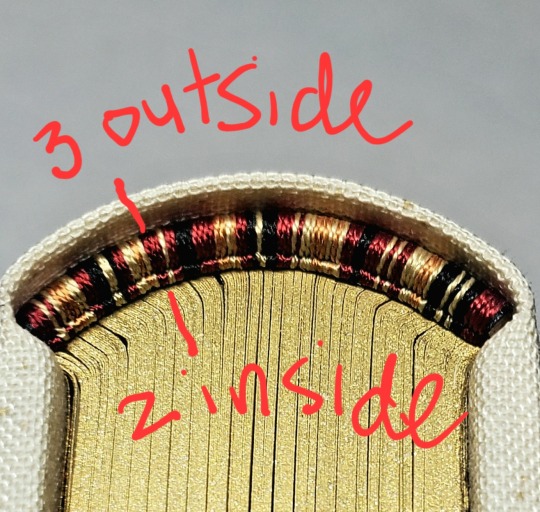
6. Pattern management. I... don't really plan much how my patterns sit on the spine, which is not very helpful. HOWEVER you can do some pattern management on the fly, if you really want your pattern to end at a certain place. Thread can be packed more or less densely on the core, resulting in some pattern compression; you could also strategically drop wraps in less noticeable locations. An unintended example: I was replicating the pattern on this endband (left) when I realize I wasn't packing the thread as densely as I had the first time around (right), which resulted in the overall pattern taking up more space. You can do this on purpose, if you need to.
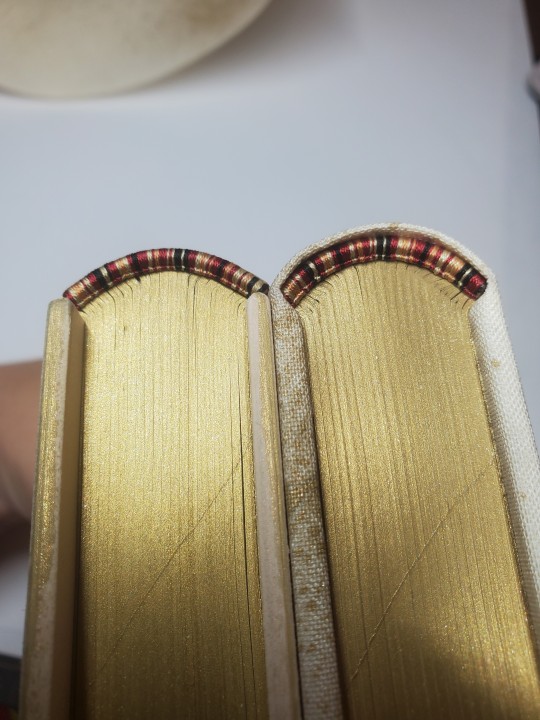
this was way more than you asked but it gave me a chance to put all this in one spot. Best of luck in vanquishing the dreaded EndWyrms.
#fanbinding#bookbinding#celestial sphere press#in progress review#ask des#i tend to shock ppl a big when i say i don't actually enjoy sewing endbands#i merely Tolerate it#all of this knowledge is 100% spite driven to reduce my own frustration
383 notes
·
View notes
Text
so I have been crocheting for maybe 18 months now, started in late 2023, and I'm learning more complex stitches and understanding how various stitches and methods create sundry effects.
and I was getting ready for bed last night and I happened to notice a doily which nonna made, which is in my room, because I grabbed it to remember her by when my sister was cleaning out the house after nonna died in 2021.
and I've been seeing doily patterns when I trawl r/crochet but it hadn't ever really clicked, you know? so I got out the magnifying glass and I took the doily under a strong light, and
and
it's crochet. it's just teeny-tiny crochet.
all this time I thought "tatting lace" or "making doilies" was some mysterious complicated thing but no, I can see the chains, I can interpret the dcs, I was just making an African flower granny hex and I can see where nonna did "24 dc into the same stitch" on this doily with the incredible thin thread and tiny hooks and I
and I
I just cried.
I'm not a great cook, I'm a terrible housekeeper, I can barely sew on a button, nonna was taken out of school in second grade and even at my best level of italian there was always a bit of a language barrier so it's not like we could discuss books or something, but here, here is something we could have shared. here is something which transcends language. it's art, it's creation, it's design. I could have showed her something and she would have gotten it, not just that she would have been proud of me, because she was always proud of me, but that she would have understood this. I could have shared this with her. we could have done this together. I could have exclaimed over her skill and maybe she could have taught me some stitches or techniques.
and she's gone. I'll never be able to share this with nonna.
I only really grieve hard over my losses once in a while but this is stabbing me right through the heart.
ti voglio tanto bene, cara nonna. I wish I could have showed you this. I wish I could have done this with you. I wish I had known.
101 notes
·
View notes
Text
Sad Mu Qing thoughts:
You know how it's a common headcanon that he not only is good a sewing, but it's something that he genuinely enjoys doing?
What if, not unlike Hua Cheng's Cave of Ten Thousand Statues, Mu Qing has a huge, private wardrobe that no one knows about except for him.
This wardrobe contains thousands of grand, luxurious robes and accessories, all created by his hand. Not one of them is the same as another, and if one were to look closely, one would discover that they were clearly organized into three main sections:
One section contains robes that are not dissimilar to his own's size, but are markedly different in color and style than anything Mu Qing would wear - rich, warm browns and yellows with accents of brick reds or burnt orange. All trimmed with gleaming, brassy gold. The fabrics are fairly heavy and practical, but forgiving. The designs all seem to have careful attention to the flexibility of the shoulders. Many of them display beautiful, finely embroidered designs depicting noble dragons or a more subtle pattern reminiscent of dragon scales.
Another section contains robes that are too small to be worn by Mu Qing, and much too light in color. - rows and rows of flowy, silky fabrics, ranging from snowy white to the palest of blues, many adorned with delicate patterns of flower petals or clouds in golds and silvers. Some are simple and airy, but others are designed with long, flowing sleeves, ornate sashes, and delicate beading with underrobes offering lovely flashes of fortuitous crimson, befitting of royalty.
In perhaps the largest section, there are endless sets of robes clearly intended for a woman. One who would have been much shorter in stature than Mu Qing, but who clearly shares his penchant for dark colors and simple yet tasteful designs. Blacks, greys, and navy blues, all in the softest, most satiny materials that would feel as light as air on the skin. On close inspection, many of these would display graceful, tasteful patterns of cherry blossoms or under-robes with just the barest hint of blush or peach pinks. These robes are clearly lovingly crafted, with their seams, sashes, and accessories of the finest silver.
No one knows the centuries Mu Qing has spent crafting and preserving such lovely robes, none of them having ever been touched or worn after their creation.
And he prefers it that way, to keep this wardrobe a secret, a shrine in reverence to the most precious and grieved relationships of his past.
There, he can pour his feelings and devotion, and not be judged or rejected.
175 notes
·
View notes
Text
I Assign Cosmere Characters A Random Animal As Their Pet
I'm using the random generator from this post. I've already created a list of Cosmere characters (it's just the main characters I always do, ha ha), and then I'll randomly assign them a pet and see how they fair! For the record, these results are not altered at all!
[For the purposes of this post, we're gonna pretend that any animal that comes up would make a good and ethical pet, okay? Please don't actually try to adopt a bear.]
1. Kaladin: A dromedary (a type of camel)
Kaladin: [stares at the camel] Camel: [stares at Kaladin] Kaladin: T-This is just a bigger, meaner horse! Kaladin: I can tell just from one glance into its eyes that that hump is full of SPITE Camel: [spits at Kaladin] Kaladin: I KNEW IT
2. Vin: A mustang (a type of horse)
Vin: Yes, yes, you think you're soooo pretty and fast, don't you? Vin: I'm faster, you know. Probably. With enough metal. Vin: So just don't you getting to big for your horse britches! Elend: Wow! What a beautiful horse! Vin: Don't you start!
3. Shallan: A monkey
Shallan: What a cute little monkey you are! Shallan: With the little outfit Adolin sewed for you, and the paintbrush I gave you! Shallan: A regular little monkey artist! Pattern: [buzzing] I keep telling you, Shallan, this creature wants to be like that one person I saw when you were looking for the herald! It wants to be paint with its p- Shallan (loudly): We'll just use regular paint, thank you!
4. Tress: A mandrill (largest monkey in the world)
Tress: Wow, you have such a pretty face, ma'am! Tress: And a large girl like you won't need to fear any mean ol' cat, will you! Charlie: I feel strangely inadequate. Tress: I-I didn't mean it that way!
5. Dalinar: A bear
Dalinar: You and I are a lot alike, bear. Dalinar: We are both large and intimidating, and we can hurt a lot of people if we get violent. Dalinar: ... Dalinar: Also, apparently Navani really likes to cuddle with both of us. Navani: He's soooo soft!
6. Painter: A bighorn (a type of sheep)
Painter: I like him. Painter: He's got a noble bearing. You can tell with those big horns and steely gaze, he's probably king of his herd or something. Painter: So please stop stacking chopsticks on his head. Yumi: Come on, he LOVES his chopstick-tower-hat! Bighorn: [making happy sheep noises] Painter: I-I just think his gravitas is taking a hit.
7. Leshwi: A burro (a type of donkey)
Lewshi: I'll admit, I was really hoping for an animal that could fly. Venli: Surely anything can fly if you lash it to the sky. Leshwi: I tried that. Leshwi: Apparently donkeys don't like to fly.
8. Adolin: A basilisk (a type of lizard)
Shallan: So...why the little cape on your lizard friend? Adolin: He runs across water! It's cool, but I thought it would look even cooler if he was wearing a cape while he did it! Shallan: Where do you find enough water for that? Adolin: Well...he's mostly been running across a bathtub. Shallan: Ah, so he REALLY needs the coolness factor of a cape... Adolin: Yeah, I think it'll really help his self-esteem.
9. Steris: A sheep
Wax: Hey Steris. Steris: Hello, Wax. Wax: I can't help but notice that where yesterday was one sheep, today there are fifteen sheep. Steris: I read that they feel better in herds! Wax: You always go all in--I love that about you. Wax: ... Steris: ... Wax: So we're sheep farmers now? Steris: A little bit, yeah.
10. Navani: A ferret
Sibling: NAVANI YOUR FERRET IS RUNNING THROUGH MY TUNNELS AGAIN Navani: It loves you! Sibling: IT'S LIKE THAT LIFT CHILD ALL OVER AGAIN
11. Siri: A budgerigar (bird)
Siri: This little guy is perfect for me! Siri: Colorful, small, sweet! Siri: I'm teaching it to talk! Budgie: Let's destroy evil! Siri: ... Siri: Uncle Vasher was here again, wasn't he?
12. Kelsier: A duckbill platypus (yes, really)
Kelsier: Everyone, meet the newest member of our team! Dockson: Uh...what is that? Vin: It looks like a bunch of different animals stuck together. Breeze: Rather unsightly, really. Ham: You, uh, doing okay, Kel? Kelsier: You're all such doubters. But watch what happens when I do THIS! [Puts a fedora on the platypus] Vin: ...Why do I suddenly feel like he's going to make a great spy? Kelsier: Trust me, this is gonna be great!
#cosmere#cosmerelists#Kaladin#Adolin#Shallan#Kelsier#Dalinar#Navani#Leswhi#Siri#Steris#Painter#Tress#Vin
96 notes
·
View notes
Text
18+
Eddie Munson x AFAB reader, established relationship, lingerie, allusions to oral sex(F), PIV sex
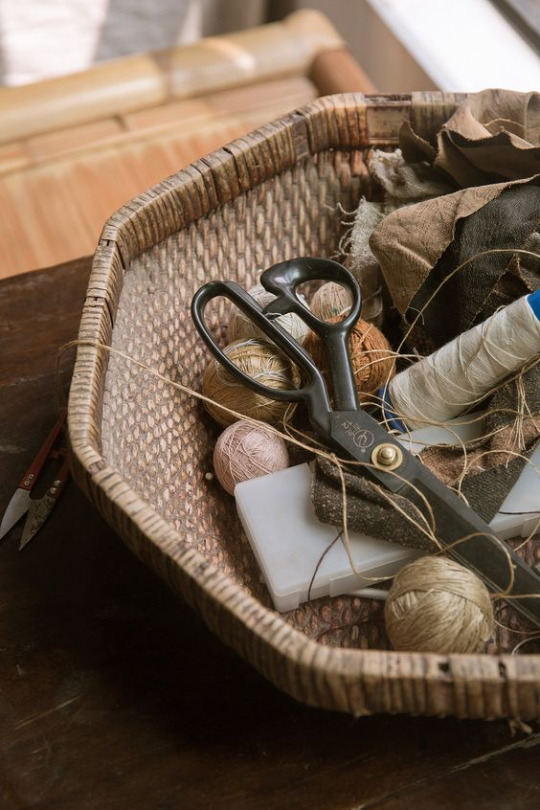


a/n: I'm no seamstress by any means but I can do a decent enough job with a needle and thread and I love making my own lingerie from time to time so it got me thinking about dear sweet horny Eddie and what it might be like when you let him in on your little hobby.

You'd first told him about it a few months into your relationship, on a day when a press of his lips to the corner of your mouth had turned into open mouthed kisses, his tongue wrapped around yours. Eddie had pulled you closer to feel more of you then, settling you in his lap, pushing your skirt up to find the black, hand sewn lacy garters circling the thickness of your thighs, made dainty and pretty with ruching and bows.
He doesn't even know what they're called – all he knows is that he likes them, a lot and he tells you so between kisses, tracing the soft fabric with his fingers, pinching the delicate lace with a low whistle. He slips in a corny but sweet line about how it makes your thighs look like they've been giftwrapped just for him and that gets a giggle out of you, telling him you made them yourself.
"You serious?", he looks up at you, amazement shining bright in his deep mahogany eyes even when you try to downplay it, telling him it's not that hard. But your modesty does nothing to stop him from thinking you're the most talented person he's ever met and he reminds you of that mixed in with more praise when you change positions and he's down on his knees, slipping his fingers under each garter while he fits his head between your legs.
"Turning up in a pretty little outfit like this? that's begging to have my tongue on you, baby. You shoulda known that", he tuts against your clothed mound, licking a broad stripe up your panties, tasting the wetness that had gathered there on the black cotton.
He only pulled out the stitching on one garter that day – unintentional of course but unavoidable too given how tightly he had to hold you down in place as you writhed. It didn't trouble you though because it was nothing you couldn't mend with your needle and some thread back at home.
From then on, whenever you feel inspired to tackle a new design he's all sorts of encouraging, driving you and accompanying you to get all the things you need – all of the sewing supplies; fabric, thread, lace, ribbon, elastic and more. He helps you decide on which colors to get and he makes the gesture of paying for it all too, wanting to spoil you. Not to mention it's kind of like he's buying himself a present too, knowing you'll model the undergarments for him when you're done.
The most you let him help with after that is taking your measurements, letting him wrap the measuring tape around your hips and bust while you guide him on how to do it correctly but what that leads to is a lot of wandering touches and a few sneaky pinches on your ass, having to playfully swat his hands away if you hope to get anything done.
Eddie backs down with a little whine but all the faux pouting's just for show. He finds space on your bed while you look up DIY tutorials online at your desk before you get down to sewing, all of your supplies laid out neatly by your side, ready to be used.
While you're busy he spends his time strumming away on his guitar, pencil tucked behind his ear as he brainstorms lyrics for a new song. Both of you liked working on your own projects this way, in the same room because you appreciate having each other's company and presence to surround yourself with while you create.
Though Eddie had promised not to look too much he struggles to uphold that promise as he sneaks peaks at you cutting out patterns for a matching lace bra and panty set. He adores the cute way your brows scrunch together in concentration when you thread your needle and how you sometimes mirror him with your tongue pinched between your lips while you meticulously stitch all the individual cut outs together.
Somewhere between the time it takes you to get the panties finished and the bra started he approaches you, one hand clamped over his eyes so he can't see your progress – he knows how much you want to surprise him with the final result. Held out in the other is a mug of that tea you like, having made a quick trip to your kitchen and back, a bag of potato chips cradled in the crook of his elbow for you too.
You thank him and gladly take the offerings, cheeks growing warm when he plants a quick kiss on the top of your head. "Don't overwork yourself", he coos into your hair, giving your shoulder a gentle squeeze before he heads back to your bed and picks up his guitar again.
The tune Eddie's playing carries you through the rest of your stitching and close to an hour later you swivel your desk chair around in his direction. "I'm done", you announce with a sunny smile and he grins back at you, fingers abandoning his guitar. "You gonna get changed right now?" he asks hopefully, eyes twinkling.
"Yup", you answer him, popping the 'P' with a little wink. You gather the set in your arms, stepping into the bathroom. "Wait here, I wanna do a reveal", you tell him before closing the door, all giddy with girlish excitement, proud of how the it all came out.
The wait isn't long but every second that passes has Eddie feeling like his head's full of fireworks, finding it impossible to remain still, fingers drumming on his knees, legs hung over the side of your bed, socked feet tapping away on your carpeted floor.
You don't announce yourself once you've changed, unlocking the bathroom door and letting it swing open as you lean against the doorframe, letting your boyfriend take in your newest creation.
You know you've succeeded when his lips part, jaw going slack and his eyes going wide to rake over every inch of you, stunned.
He makes grabby hands at you and its somehow made cuter given his age so you step forward to let him get a closer look, occupying the space between his spread legs, letting him place his warm hands on the bare skin of your waist.
It's always a rare moment when Eddie goes silent, words escaping him as he quietly admires the way the material wraps around your proportions perfectly and the the cheeky cut of your panties as you do a little spin for him, the front a soft lilac satin, the back a matching shade of lace to reveal your ass through the floral embroidery.
The bra is simple – nothing too elaborate like some of the designs you'd scrolled through but it compliments the underwear well. The straps are thin and rest comfortably on your shoulders, the rest sewn in a longline style. It's sheer with the same floral lace as your panties so your nipples show through, your breasts supported well even without padding or underwire for extra softness, all with a tiny, pretty ribbon bow stitched right in the middle to match the one on the front of your panties too.
"You're so fucking beautiful", me utters, pulling you closer to kiss you right above your belly button, making your chest flutter with a thousand beating wings, a hurricane of butterflies taking flight just beneath your skin.
You let him lay you down on the bed and he's far more gentle than he needs to be when he slips your panties to the side, not wanting to stretch or snag the lace and ruin all your hard work. Your belly feels warm like sunlight spilling through your window in the morning because he's so careful with the pretty underwear while he runs a finger through your wet folds, making you feel like something as delicate as porcelain, something to touched with care and worshiped. It makes you hunger for more, pulling him closer by his shoulders.
"Wanna feel you inside", you place your lips on his, hands helping him to unbuckle his belt as he leans over you. You pull not so gently at his clothing, a big contrast to how he's handling you, tossing each article to the side impatiently while you remain in your cute little ensemble. You wouldn't be ridding yourself of your underwear tonight and he wouldn't have it any other way.
"Can't believe I've got the prettiest doll in town all to myself", Eddie huffs a breath against the column of your neck at the same moment you suck one in, pressing his cock inside you, so thick and hard it makes the stretch that much better.
"And she's all dressed up just for me"
528 notes
·
View notes
Text
To Boldly Sew: The Creation of Star Trek's Iconic Wardrobe
Gene Roddenberry’s arguments with NASA, costumes crafted from shower curtains, male characters in miniskirts, and why the gold command uniforms were actually green—this is the story of Star Trek’s groundbreaking wardrobe and the visionary work of the man behind it, Bill Theiss.
If you’d like to read the formatted article with easily accessible references, you can also find it on AO3.
During the production of the original Star Trek, the creative team faced numerous challenges, the most persistent being, unsurprisingly, the show’s limited budget. These restrictions had a significant impact on many aspects of the series, including one of its most crucial visual elements: the wardrobe.
Each week, the costume department was tasked with creating original outfits for the show’s characters. Alien civilizations had to look distinct and believable without distracting from the storyline—all while staying within a tight budget. To achieve this, the team employed clever tricks, such as repurposing and dyeing old uniforms, turning garments inside out, and even fashioning costumes from unconventional materials like vinyl shower curtains.
"Sometimes a show will call for 30 or 40 costumes," explained Star Trek’s costume designer William "Bill" Theiss. "And since we film back to back, that means I have to design, get approval from the producers and director, and construct the costumes in six to eight days." [Source]

Commander Spock and Lieutenant Tormohlen don "protective suits" fashioned from shower curtains as they investigate the mysterious death of a mannequin crew member. (Season 1, Episode 4, "The Naked Time.")
Theiss was a key figure in shaping the visual identity of Star Trek’s universe. Over the course of the show’s three seasons, he designed costumes for a wide range of characters, from blue-skinned Andorians to the infamous Orion slave girls, and even the Nazi-inspired inhabitants of the planet Ekos. (Interestingly, the episode Patterns of Force, featuring Ekos, was banned from German television until 1995 due to its controversial themes.) [Source]
Theiss first met Star Trek creator Gene Roddenberry while Roddenberry was developing the show’s pilot. At the time, Theiss had gained attention for his innovative work on the science fiction play The Veldt, based on Ray Bradbury’s short story of the same name. This caught the eye of Star Trek writer Dorothy Catherine Fontana, who introduced Theiss to Roddenberry. By then, Roddenberry had already interviewed over a dozen costume designers but had yet to find someone who could bring his vision to life. Theiss’s creative approach, which often involved crafting unique costumes from unconventional materials, immediately resonated with Roddenberry. Their collaboration would continue for decades, even though, amusingly, Theiss never learned how to sew. [Source]
After the original Star Trek series was canceled, Theiss and Roddenberry remained close collaborators, working together on various projects until Roddenberry’s passing in 1991.


Left: William Theiss adjusts Susan Oliver's costume on the set of the 1965 pilot episode, "The Cage."
Right: William Theiss and Leonard Nimoy on the set of Season 2, Episode 26, "Assignment: Earth" (1968).
When designing Star Trek’s now-iconic multi-colored uniforms, Roddenberry drew inspiration from the color-coded uniforms used on American naval vessels, where quick role recognition was essential in low-visibility environments. As a former military pilot during World War II and later a police officer, Roddenberry had firsthand experience with structured, hierarchical organizations. These influences shaped not only Star Trek’s command structure but also its visual design. [Source]
Each division was assigned a distinct color: engineers, communications officers, and security personnel wore red; medical staff and scientists were dressed in blue; and command officers wore—believe it or not—green. (But more on that later.) All uniforms were paired with dark ash-colored trousers and high boots.
Star Trek is not typically associated with realism, which makes it surprising to learn that NASA was involved in the show’s production, offering advice to ensure it was "scientifically believable." Among their suggestions was the idea that 23rd-century astronauts might wear form-fitting jumpsuits. However, Gene Roddenberry dismissed the concept, humorously referring to the design as “long underwear.”
NBC, on the other hand, had entirely different priorities. The network insisted that female Starfleet officers wear more revealing attire, a demand that clashed with Roddenberry’s vision of a future where women were treated as equals to men. In the first pilot episode, The Cage (1965), Roddenberry boldly dressed female characters in pants—an unconventional choice for 1960s television. However, after much debate with the network, a compromise was reached: miniskirts. Highly fashionable at the time, they were paired with shorts and dark tights, blending contemporary trends with Star Trek’s futuristic aesthetic. [Source]

Captain Pike and a group of serious women in pants protect the heroine from an ass-headed very wise alien. The first pilot of Star Trek, "The Cage" (1965).
Years later, when NBC faced accusations of sexism and objectifying women, Nichelle Nichols, who played Uhura, defended the wardrobe choice in a BBC interview. She explained that the miniskirts weren’t unusual or inappropriate for the era:
“I was wearing them on the street. What's wrong with wearing them in the air? I wore 'em on airplanes. It was the era of the miniskirt. Everybody wore miniskirts.” [Source]
Grace Lee Whitney, who portrayed Janice Rand, echoed Nichols’s sentiment, adding that she “didn't think the women should be in pants” and that she wanted to “look like Flash Gordon” on screen. [Source]
Meanwhile, costume designer Bill Theiss had his own, more subtle approach to creating “revealing” costumes.
“He felt that revealing non-sexual flesh (the outside of the leg, off one shoulder, the back) promised that the viewer would see more — but they never did,” explained screenwriter D.C. Fontana, citing the gown worn by Lt. Palamas in Who Mourns for Adonais? as a prime example. [Source]
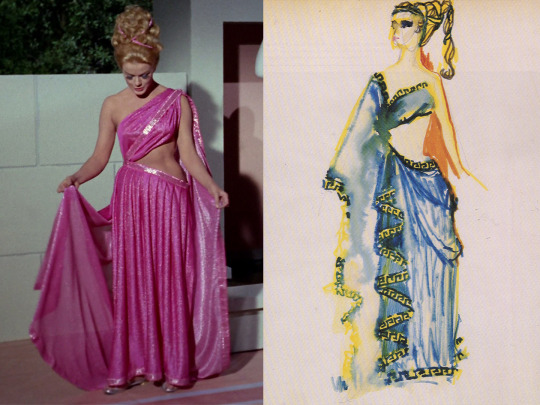
Lieutenant Palamas's "ancient Greek" dress from the episode "Who Mourns for Adonais?" alongside William Theiss's original sketch for the design.
When designing the original Star Trek uniforms, Theiss was tasked with creating something that reflected military influences while also looking futuristic and remaining inexpensive to produce. His approach was practical:
“As for where I get my ideas from… well, I don’t get them from my dreams or anything. Mainly, I get them from fabric that I see that’s available; I look for interesting patterns in the material itself,” Theiss once explained. [Source]
For the first two seasons, the Star Trek uniforms were made from velour, a newly invented fabric that was cheap, easy to maintain, and had an appealing sheen under studio lights. However, velour had its drawbacks: it tore easily (as evidenced by Captain Kirk’s frequent shirt-ripping battle scenes...) and shrank significantly after dry cleaning. Since the costumes had to be cleaned after every episode, viewers may notice that the uniforms became progressively tighter throughout the first two seasons. By the third season, velour was replaced with double-knit nylon, a more durable fabric used in professional baseball uniforms.
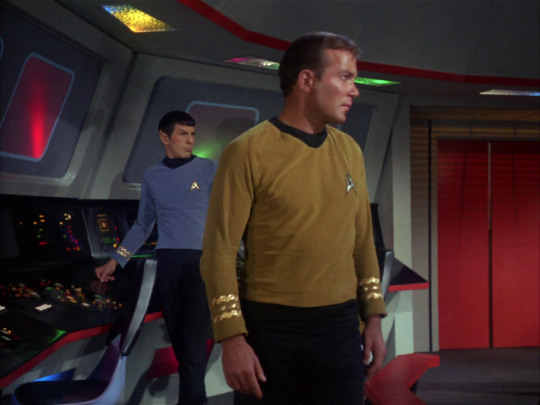

Left: Kirk's velour shirt from Season 1, Episode 10, "The Corbomite Maneuver." Right: The same shirt in Season 2, Episode 22, "By Any Other Name." Shatner is diligently sucking in his stomach.
This brings us to another interesting aspect of the original velour uniforms—their appearance on screen.
“It was one of those film stock things,” Theiss explained. “It photographed one way—burnt orange or gold. But in reality, it was another; the command shirts were definitely green.” [Source]
So, what color was Captain Kirk's uniform really? In truth, Kirk's uniform—like the rest of the command crew's—was olive green. However, under the bright studio lighting and the quirks of 1960s film stock, it appeared gold on screen. The greener hue becomes more noticeable in scenes filmed on location with natural light. The difference is also evident in photos of the original uniforms on display, such as those taken at an exhibit in Detroit, USA. In one image, taken under dimmer lighting without flash, the fabric looks closer to its true green color; in another, taken with flash, it appears more golden.


Left: Kirk's velour shirt photographed without flash—olive green. Right: Kirk's velour shirt photographed with flash—yellow gold.
This might come as a surprise to Star Trek fans, but it makes sense when you consider that Kirk's alternate uniforms—the wrap-around tunic and dress uniform—were distinctly green. This wasn’t an intentional design difference; those variations were simply made from a different fabric that didn’t react to light the way velour did.

“The problem is that a lot of my work is seen on screen for only two to three seconds, and even then, it might be in bad light or at a bad angle,” Theiss noted. “But then, you can't really justify taking two hours to light and block a scene just to showcase a costume.” The play's the thing, according to Theiss. "That's what it's really all about. It's not about the costumes." [Source]
The color discrepancy of the uniforms became an interesting challenge when animators began working on Star Trek: The Animated Series in 1973. They had to decide whether to depict the uniforms in their originally intended green or the gold shade that had become iconic to audiences.
At the time of Star Trek's release, many viewers were watching on black-and-white televisions, making it impossible for them to discern the true colors of the uniforms. At the Kirk/Spock convention, @kiscon, I spoke to a longtime Trek fan who told me she had no idea what color the uniforms were when she first watched the show as a teen. For those fortunate enough to see the series in color, however, the command uniforms became strongly associated with yellow. As a result, changing the uniforms to their intended green in Star Trek: The Animated Series would likely have confused audiences who had grown accustomed to the gold appearance on screen.
Ultimately, the gold uniform was canonized in The Animated Series and used in all fan materials until the release of the Star Trek feature films. Meanwhile, the trousers—whose color had also been slightly distorted on film—remained their original dark ash shade.
Because of these discrepancies, fans often debate which version of the uniform to follow when cosplaying or creating visual content. Many cosplayers choose to replicate the original olive-colored velour, trusting that proper lighting will naturally recreate the golden appearance seen on screen. Others opt for the now-iconic gold shade, reflecting the way the uniform has been depicted in official materials for decades.

Star Trek: The Animated Series (1973).
Ironically, NASA was right in its assumption that jumpsuits would become the norm for astronauts, and Roddenberry was forced to use them in the first feature-length Star Trek film, 1979's Star Trek: The Motion Picture. The multi-colored shirts were rejected by the studio as too garish, and the miniskirts worn by Uhura and most of the female crew members were already considered a relic of the sexist 1960s by 1979.
William Theiss, who designed the costumes for the original series, was too busy with other projects to work on the film, so Gene Roddenberry brought in a new costume designer, Robert Fletcher, who created the Starfleet uniforms now remembered as the worst in the franchise's history. In an effort to avoid comparisons to military uniforms, the studio opted for muted tones ranging from pale blue to dirty beige and nude shades. The result? The Enterprise crew looked more like spa staff than starship officers, and some background extras in nude-tone bodysuits appeared practically naked on screen. Not only did these uniforms make it impossible to distinguish the characters' ranks and departments, but they were also surprisingly impractical. The suits were sewn onto the actors' shoes, meaning they needed an assistant every time they went to the bathroom.

Star Trek: The Motion Picture (1979).
Luckily for us all, in the next film, Star Trek II: The Wrath of Khan (1982), it wasn’t just Khan who was filled with rage—the cast themselves rebelled and outright refused to wear the dreadful jumpsuits again.
Despite the failure of his design, Robert Fletcher remained as costume designer for the next three films, promising changes. In Star Trek II: The Wrath of Khan, the uniforms returned to a more military style, with the lead actors wearing maroon jackets with overlapping lapels that they could dramatically unbutton if their character was meant to look tired or stressed. If you look closely, you’ll notice that these maroon uniforms were actually redyed and slightly modified versions of the jumpsuits from The Motion Picture. The reason for the maroon color? It was the best shade that worked with the existing fabric from the first film. [Source]
William Theiss, reflecting on Fletcher’s designs, commented:
“Bob Fletcher is a very fine designer, and I mean that very sincerely. We don’t design the same way, and there’s no reason we should—or could. It’s apples and oranges. But my personal feeling is, if you go to a structured, woven fabric and do the kind of tailoring and structuring he’s done, it puts those costumes back, historically, 500 years, with shoulder seams and shoulder pads of that type.” [Source]
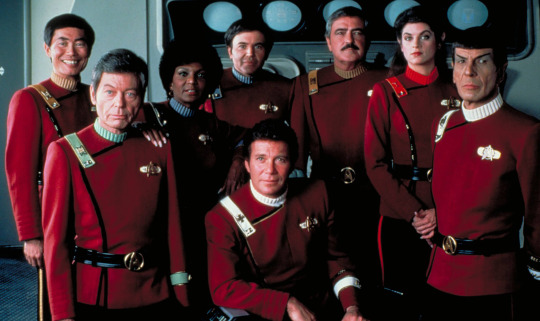
Star Trek II: The Wrath of Khan (1982). Everyone turned red with anger.
In Star Trek: The Next Generation, Roddenberry reunited with Bill Theiss, and together they decided to bring back the iconic miniskirts as part of the uniform, but with a twist—they wanted to make them inclusive. In The Next Generation, male crew members were occasionally seen wearing the same miniskirts or “scants” (a hybrid of skirts and pants), reflecting Roddenberry and Theiss’s vision of a future where gender norms no longer dictated clothing choices.
However, the social climate of the 1980s and 1990s wasn’t as receptive to this progressive idea.
“Having both actresses and actors in skirts was meant to diffuse any sexist accusations that might have been associated with designs from the old show,” Theiss explained. “It’s also fashionably probable that, 400 years from now, men would wear skants. Even so, there was usually a problem on the set,” he admits, “because some wisecracks were always made.” Theiss emphasized that he wanted his actors to feel at ease in the designs. “I won’t force an actor or actress to wear something they’re not at least 80 percent comfortable with.” [Source]

While Theiss’s designs were undeniably groundbreaking, he was known to be a challenging person to work with. Constantly preoccupied with time and budget constraints, Theiss had little patience for anyone—whether they were directors, producers, or even Gene Roddenberry himself. He was even less tolerant of people who approached him simply to praise or critique his work, or even just to say hello. His philosophy was simple: “Better to be rude than to delay filming.”
Actors, extras, and costume assistants often recalled how Theiss would dart around the set, frantically hemming, tucking, and adjusting costumes between takes. Many of the alien outfits seen on the show weren’t actually "costumes" in the traditional sense. Instead, they were often assembled from patches, ribbons, scarves, curtains, and wire, with actors being "stitched into" them directly on set. [Source]
For example, Janice Rand's iconic beehive hairstyle was crafted from several wigs braided together over a cone. Grace Lee Whitney, who played Rand, recalls running back and forth between the dressing room and Roddenberry’s office with Theiss, constantly piling on more hair. Each time, Roddenberry would stare at her intensely, then declare, “Higher!” Whitney and Theiss would rush back to add more wigs until the hairstyle reached its iconic height. [Source]

One Smithsonian Institute employee, who worked with Theiss in 1992 while preparing for a Star Trek costume exhibit, recalls combing through the Paramount warehouse filled with racks and boxes of costumes. She was amazed to discover that most of the "costumes" were actually scraps of fabric neatly hung on a single hanger. Yet, when these scraps were sewn, tied, and pinned together, they became the iconic designs we now associate with Star Trek.
Andrea Weaver, one of Theiss’s fellow costume designers on the original series, remembers:
“Bill Theiss was a creative designer. His designs for Star Trek were original, rather than distilled from other sources or redefinitions of previous works. This is what I appreciated about Bill Theiss. I thought he was a truly unique and rare costume creator.” [Source]
William Ware Theiss’s contributions to Star Trek are legendary. His uniforms for both Star Trek: The Original Series and Star Trek: The Next Generation remain iconic, instantly recognizable even by those who aren’t fans of the franchise. His innovative, DIY approach to creating futuristic costumes brought a distinctive charm to the original series and left an enduring legacy.
Here are some of his most memorable designs:


Left: Season 2, Episode 11: "Friday's Child" Right: Season 3, Episode 13: "Elaan of Troyius"
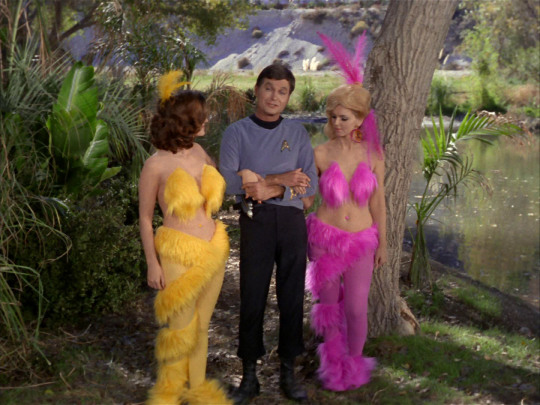

Left: Season 1, Episode 15: "Shore Leave" Right: Season 3, Episode 20: "The Way to Eden"
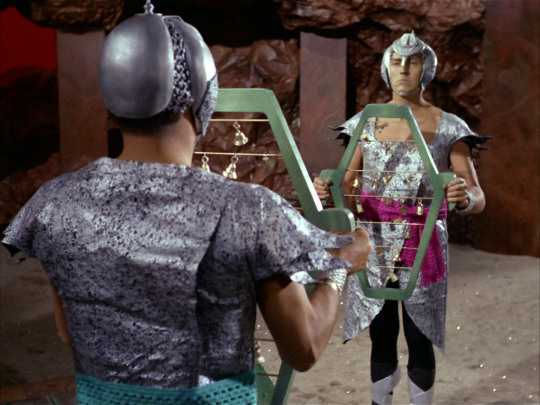

Left: Season 2, Episode 1: "Amok Time" Right: Season 1, Episode 23: "A Taste of Armageddon"


Left: Season 2, Episode 9: "Metamorphosis" Right: Season 1, Episode 6: "Mudd's Women"


Left: Season 3, Episode 5: "Is There in Truth No Beauty?" Right: Season 1, Episode 15: "Shore Leave"


Left: Season 1, Episode 23: "A Taste of Armageddon"Right: Season 2, Episode 16: "The Gamesters of Triskelion"


Left: Season 3, Episode 11: "Wink of an Eye" Right: Season 3, Episode 8: "For the World Is Hollow and I Have Touched the Sky"
#star trek#star trek tos#spock#kirk#s'chn t'gai spock#star trek the original series#star trek tng#star trek the next generation#star trek the motion picture#star trek the animated series#star trek the wrath of khan#articles#eldar of zemlya#captain kirk#james t kirk#behind the scenes#wardrobe#costume#costume design#costume department#filmmaking#gene roddenberry#bill theiss#william shatner#leonard nimoy
144 notes
·
View notes
Text
Patternmaking, both basic and creative: The Shapes of Fabric

Once upon a time I used to follow the blog of someone who worked in the fashion industry who would write irate posts on fitting and quality issues, teaching me in the process why ready to wear trousers never fit properly, exactly how to set a sleeve, and why T-shirts sometimes start to turn themselves into corkscrews once you've washed them. I'm pretty sure this is not that blog, but I think I found it when I was trying to find the aforementioned one again.
The Shapes of Fabric is a really cool blog with a mix of basic guides like drafting pattern blocks (a base pattern you can use to create more complex garments) and really fun patternmaking experiments that are basically practical geometry.
If you're going to use older sewing sources, it's often really helpful to have at least a basic grasp of what pattern drafting is and how it works, so I'll be linking to some tutorials on how to draft some basic pattern blocks (bearing in mind that I've probably not used this source in particular, but the idea is more or less the same however you explain it):
pattern making basics
how to use basic pattern blocks
bodice block
dartless bodice block
pants block
The site also has a bunch of helpful guides, like these ones:
welt pockets
fitting bodices
fitting pants and skirts
sewing plackets and collars
more on collars
jacket sewing
sewing sleeves
sewing pants
There's also some really cool posts on dart manipulation, flounces, ruffles, "patterns that create patterns" (if you want to go off in a retro futurist way this kind of thing would be neat to incorporate), funky things you can do with sleeves, tucks (v useful if you're into Victorian stuff), detachable collars. Basically, go have a look around and get inspired!
#historical dress reference series#sewing resources#pattern drafting#not strictly historical but very useful#a lot of the techniques they do funky stuff with can be used in a more basic version for vintage and historical fits#i have yet to decide on a posting schedule for this series but i'm procrastinating a sewing project by drafting a few posts for it#so we might as well have this one today#if anyone magically knows what the other blog i'm talking about might be please send it my way#i just logged into my rss reader for the first time in years to see if i have it saved there
74 notes
·
View notes